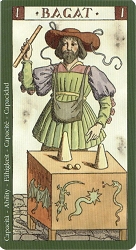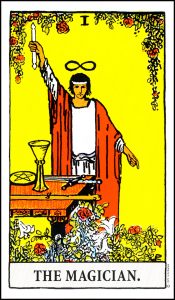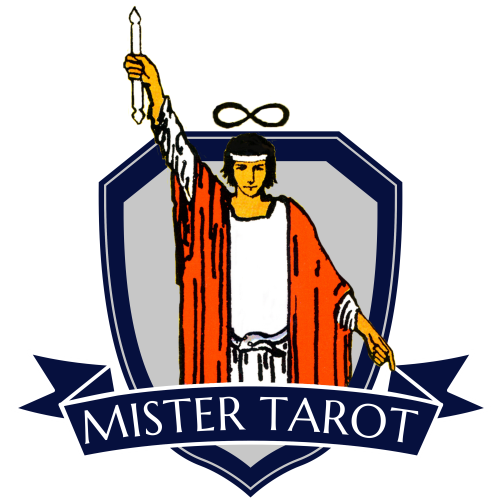In the earliest Tarot cards, The Magician was depicted as a medieval fairground hustler, performing sleight of hand and illusion. How did he end up becoming such a creative, dynamic force within the modern Tarot?
 ‘Mountebank’ was a word originally associated with this card: it’s an old word that meant the seller of quack medicines, or a charlatan, or one who performed conjuring tricks. These street entertainers were familiar figures in 14th and 15th century Northern Italy when Tarot was being developed.
‘Mountebank’ was a word originally associated with this card: it’s an old word that meant the seller of quack medicines, or a charlatan, or one who performed conjuring tricks. These street entertainers were familiar figures in 14th and 15th century Northern Italy when Tarot was being developed.
One of the main tricks by a mountebank was the cups and ball game. In its modern version, a ball is placed under one of three cups and they are switched around under the con man’s hands and the ‘player’ has to guess which container hides the ball. This piece of street gambling has been so successful at entertaining punters, and making a profit for the performer, that I saw it being played on street corners in Europe just a few years ago.
The Italian name for this card is il bagatto, or il bagatello, which means juggler, and a juggler is yet another type of street performer. An example of how translation problems have affected the eventual design of Tarot cards is that in the dialect of Milan, the word bagatello is similar to the word for cobbler (bagatt). Milanese Tarot cards therefore depicted The Magician as a cobbler, working on a shoe at his table.
Throughout the history of Tarot, the Juggler was depicted as either a craftsman or a street performer, or as a mixture of both, as card makers just copied images from previous decks without attributing much significance to the symbols. However, when the occultist Éliphas Lévi designed and drew this card, he brought about a significant change to the Juggler’s persona. He depicted him holding one of the suit symbols, with the rest laid out on a table in front of him. To complete the transformation of this card, Paul Christian, who was a devotee of Lévi, renamed The Juggler as The Magus, and the change from a sleight of hand magician to a metaphysical mage was almost complete.
 A. E. Waite then emphasised The Magician’s creative powers by pointing the wand to the heavens and his left hand to the earth, reflecting the Hermetic doctrine, ‘as above, so below’. The Magician became a master of metaphysical secrets, one who could call on the powers of the universe to bend reality in accordance with his will. This iconic image of The Magician has been a standard on modern decks ever since.
A. E. Waite then emphasised The Magician’s creative powers by pointing the wand to the heavens and his left hand to the earth, reflecting the Hermetic doctrine, ‘as above, so below’. The Magician became a master of metaphysical secrets, one who could call on the powers of the universe to bend reality in accordance with his will. This iconic image of The Magician has been a standard on modern decks ever since.
Is The Magician a mountebank or a practitioner of High Magic? Maybe, due to his association with the Greek God Hermes, he is a bit of both. Hermes is a trickster God who is both a God of Wisdom, and the patron God of thieves!
The Magician card has become a simple, but powerful image. Through the influence of occultists from the last two centuries, the person on this card has evolved from being a sleight of hand conman, to a masterful adept. The occultists saw the potential of this image — they redesigned the image of this card to produce a magician who can combine material and spiritual powers. Despite his previous, dubious reputation, The Magician is now a creative, dynamic force within the Tarot.
